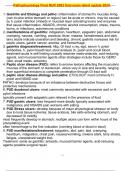Pathophysiology Final NUR 2063 final exam latest update 2024
1. Gastritis and Etiology and patho: inflammation of stomach's mucolas lining
(can involve entire stomach or region) can be acute or chronic. may be caused
by h. pylori infection (imbeds in mucosal layer activating toxins and enzymes
that cause inflammation. NSAIDS, chronic alcohol consumption, stress, trauma,
burns, or infections, autoimmune conditions
2. manifestations of gastritis: indigestion, heartburn, epigastric pain, abdominal
cramping, nausea, vomiting, anorexia, fever, malaise. hematemesis and dark,
tarry stools indicate ulceration and bleeding. chronic gastritis increases risk for
peptic ulcers, gastric cancer, anemia, and hemorrhage.
3. gastritis diagnosis/treatment: h&p, GI tract x ray, egd, serum h. pylori
antibodies, h. pylori breath test, stool analysis (h. pylori and occult blood
treatment-acute is self limiting ususally resolves meds-antacids, acid-reducing
agents, and mucosal barrier agents other strategies include those for GERD
(diet, small meals, antacids)
4. Peptic ulcer disease (PUD): refers to erosive lesions affecting the muscularis
mucosa of the stomach or duodenum. ulcers vary in size and severity, ranging
from superficial erosions to complete penetration through GI tract wall
5. peptic ulcer disease etiology and patho: ETIOLOGY: most commonly H.
pylori and NSAID use.
PATHO: develops because of an imbalance between destructive forces and
protective mechanisms
6. PUD duodenal ulcers: most commonly associated with excessive acid or H.
pylori infections
typically present with epigastric pain relieved in the presence of food
7. PUD gastric ulcers: less frequent-more deadly typically associated with
malignancy and NSAIDS pain worsens with eating
8. PUD Stress ulcers: develop because of major physiological stressor on body
due to local tissue ischemia, tissue acidosis, bile salts entering stomach, and
decreased GI motility
most frequently develop in stomach; multiple ulcers can form within hours of the
precipitating event
often hemorrhage is the first indication (vomiting blood or blood in stool)
9. PUD manifestations/treatment: epigastric, abd. pain, abd. cramping,
heartburn, indigestion, chest pain, nausea/voimiting, melena (dark, tarry stools),
fatigue, unexplained weight loss
Treatment: same as gastritis: antacids, mucosal barrier agents, acid-reducing
agents possible surgical repair
, Pathophysiology Final NUR 2063 final exam latest update 2024
10. Iron-deficiency Anemia: Not enough iron for hemoglobin production
erythrocytes pale and small
Etiology: decreased iron consumption/absorption, increased bleeding
manifestations in addition to "anemia": brittle nails, headache/irritability, pica,
cyanosis of sclera of eyes, delayed healing
11. Anemia: common acquired or inherited disorder of erythrocytes that impairs
the bloods oxygen-carrying capacity.
ETIOLOGY: decrease in # of circulating erythrocytes, reduction in hemoglobin
content, presence of abnormal hemoglobin
MANIFESTATIONS: weakness, fatigue, pallor, syncope, dyspnea, tachycardia
12. Pernicious anemia: B12 deficiency or megaloblastic anemia large,
immature erythrocytes.
usually lack of intrinsic factor (protein necessary for b12 absorption in stomach)
b12 is needed for cell division and maturity. too little b12 gradually causes neuro
problems because of the breakdown in myelin, neuro effects may be seen before
anemia is diagnosed.
Additional manifestations: bleeding gums, diarrhea, impaired smell, DTR loss,
anorexia, personality/memory changes, + babinski sign, stomatitis, paresthesia of
hands and feet, unsteady gait
13. aplastic anemia: bone marrow fails to make enough blood cells leading to
pancytopenia
MANIFESTATIONS: general anemia, leukcytopenia, and recurrent infections
can be caused by cancers, cancer treatment, pesticides 14. Sickle cell
anemia: genetic, hemoglobin-s trait vs. gene crescent shape during times of
hypoxia, can clump together and clog vessels. MANIFESTATIONS: swelling in
hands and feet, sickle cell crisis, abd. pain, bone pain, jaundice, skin ulcers,
stroke, chest pain tissue ischemia and necrosis.
electrophoresis and stem cell transplant may cure
15. thalassemia: genetic, not RBC problem, hemoglobin problem. lack one or 2
proteins that make up hemoglobin
MANIFESTATIONS: heart failure, splenomegaly, hepatomegaly, bone deformities,
jaundice, fatigue, dyspnea
16. Idiopathic thrombocytopenia purpura (ITP): hypocoagulopathy due to
immune system destroying its own platelets (autoantibodies) Circulating IgG
reacts with the platelets which are then destroyed in the spleen and liver. can be
acute or chronic
ETIOLOGY: idiopathic, autoimmune disease, live vaccines, immunodeficiency
disorders, viral infections
, Pathophysiology Final NUR 2063 final exam latest update 2024
Manifestations: abnormal bleeding (petechiae, epistaxis [nose bleed], hematuria)
ACUTE TREATMENT: glucocorticoid steroids, immunoglobulins, plasmapheresis
and platelet pheresis
CHRONIC TREATMENT: splenectomy, blood transfusions, immunosuppressants
17. Thrombotic thrombocytopenia purpura: coagulation disorter d/t deficiency
of enzyme responsible for cleaving von Willebrand factor
increased clotting which decreases available platelets --> bleeding under skin
and purple colored spots called "purpura" manifestations:
thrombi>thrombocytopenia>bleeding purpura, LOC changes, confusion, fatigue,
fever
18. Thrombocytopenia: a condition in which there is an abnormally small number
of platelets circulating in the blood
19. hemostasis: stoppage of bleeding
1. vasospasm (vasoconstriction)-brief reflex blood vessel narrows to decrease
blood flow to injury and increase bp
2. platelet plug formation-involves activation, aggregation, and adherence of
platelets into a plug that serves as a barrier against blood flowing out of vessel. 3
coagulation-or clotting changes blood into gel through cascade of events. fibrin
mesh is cleaved from fibrinogen. fibrin acts like glue during clot formation holding
the platelet plug together. Once blood flow is stopped tissue repair can begin
20. parathyroid hormone (PTH): Works in opposite way to calcitonin to regulate
serum calcium levels. PTH secreted with Ca levels drop. PTH increases
osteoclast activity which releases Ca from bone. Also increases absorption of Ca
in GI tract and kidneys. PTH also regulates phosphate levels by reducing renal
reabsorption of phosphate in proximal tubule and increasing the uptake from the
intestines and bones into blood
21. hyperparathyroidism and etiology: condition of excessive PTH production
by parathyroid glands
causes: tumors, hyperplasia, chronic hypocalcemia (renal failure)
22. hyperparathyroidism manifestations/treatment: osteoporosis, renal
calculi, polyuria, abd. pain, constipation, fatigue, weakness, flaccid muscles,
dysrhythmias, hypertension, depression, forgetfulness,
23. Cushing's syndrome: excessive cortisol that results from the increased
ACTH levels
24. Cushing's syndrome etiology: iatrogenic from ingestion of glucocorticoid
meds, adrenal tumors that secrete glucocorticoids, pituitary tumors that secrete
ACTH and cortisol, and paraneoplastic syndrome (rare disorders triggered by
abnormal immune response to a cancerous tumor called neoplasm)




